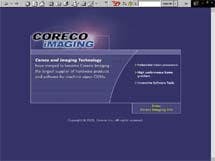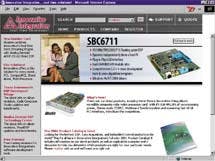Wilson's Websites
Development systems
dspvillage.ti.com
The Texas Instruments (Dallas, TX) Web site is replete with data sheets, technical articles, and application notes. Of special interest is the company's latest introduction—the TMS320C6000 DSP Imaging Developer's Kit designed for rapid prototyping of video and imaging systems. As well as supplying a simple way for developers to digitize, process, and display images, the kit features an image- and video-processing library that consists of a downloadable collection of 22 high-level optimized imaging modules for the C6000 DSP.
Imaging boards
www.coreco.com
Manufacturer of PC-based frame grabbers, image processors, and display controllers Coreco Imaging (Bedford, MA) was also one of the first imaging companies to adopt a TI DSP. As a C6201-based vision engine for the PCI bus, the Cobra/ C6 vision processor incorporates the TMS320C6201 DSP, a pixel-processor module that speeds up image-processing and acquisition modules for RGB (red, green, blue) color acquisition and 10-bit high-frequency monochrome acquisition.
Boards and systems
www.hema.de
The web site of hema Elektronik (Aalen, Germany)—a manufacturer of boards and turnkey systems for machine vision, plant engineering, and industrial processing—includes a number of DSP-based boards, for example, the PCI-DSP5, a full-length PCI board that uses the TMS320C44 floating-point DSP. Analog interface boards can be added using a connector for piggyback modules. According to the company, further analog and frame-grabber modules are being developed.
Automation and control
www.sk-tech.com/products.html
The S&K Automation and Robotics Division (Houston, TX) specializes in system-level solutions for automation and control. The company's Web site highlights products that range from board-level electronics to intelligent software packages. Of special interest is the Neural Network Simulator package and the TMS320 DSP Algorithm Standard Code Constructor, a dialog-box plug-in that generates skeleton code using a TMS320- algorithm standard interface.
Imaging in France
www.hsp.fr/english.htm
Products using DSPs, FPGAs, acquisition tools, software tools, services, and training are highlighted on the site of High-tech Services Partners (Guyancourt, France), a company that develops and integrates signal- and image-processing systems. In addition to featuring the company's range of C62- and C67-based PCI motherboards with slots for TIM modules, the site describes several robotics and medical-imaging applications.
Capture, process, and display
www.innovative-dsp.com
Offering a range of data-acquisition, DSP, video-acquisition, and display products and software, Innovative Integration (Simi Valley, CA) has entered the image-processing market with its Vista TMS320C6711 DSP board. Based around a 64-bit PCI interface, this board accepts standard composite and S-video signals and outputs composite, S-video, or RGB-compatible video. Intended for applications requiring dedicated video processing, such as factory automation and process control, the Vista board delivers a maximum processing throughput of 900 MFLOPs.



